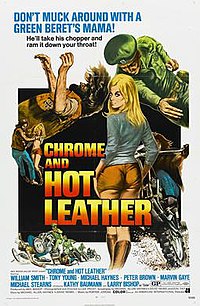
"The Ballad of the Green Berets" is a patriotic song in the ballad style about the United States Army Special Forces. It is one of the few popular songs of the Vietnam War years to cast the military in a positive light. In 1966 it became a major hit, reaching No. 1 for five weeks on the Billboard Hot 100 and four weeks on Cashbox. It was also a crossover hit, reaching No. 1 on Billboard's Easy Listening chart and No. 2 on Billboard's Country survey.

The A-Team is an American action-adventure television series that ran on NBC from January 1983 to March 1987 about former members of a fictitious United States Army Special Forces unit. The four members of the team were tried by court martial for a crime they had not committed. They were convicted and sentenced to serve terms in a military prison, but later escaped to Los Angeles and began working as soldiers of fortune, while trying to clear their names and avoid capture by law enforcement and military authorities. The series was created by Stephen J. Cannell and Frank Lupo. A feature film based on the series was released by 20th Century Fox in 2010.

Aaron Bank was a United States Army colonel who founded the US Army Special Forces, commonly known as the "Green Berets". He is also known for his exploits as an OSS officer during World War II, when he parachuted into France to coordinate the French Resistance and organizing an operation intended to capture Adolf Hitler. In retirement, Bank warned about terrorism and modern technology. He is largely responsible for the high level of security at U.S. nuclear power plants since the early 1970s.

The United States Army Special Forces (SF), colloquially known as the "Green Berets" due to their distinctive service headgear, are a special operations force of the United States Army.

The Special Forces Tab is a service school qualification tab of the United States Army, awarded to any soldier completing the Special Forces Qualification Course at the U.S. Army John F. Kennedy Special Warfare Center and School, Fort Bragg, North Carolina. Soldiers who are awarded the Special Forces Tab are authorized to wear it, as well as the green beret for the remainder of their military careers, even when not serving in a Special Forces command.
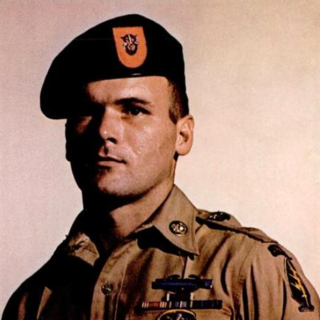
Barry Allen Sadler was an American soldier, singer/songwriter, and author. Sadler served as a Green Beret medic, achieving the rank of Staff Sergeant. He served in the Vietnam War from late December 1964 to late May 1965. Most of his work has a military theme, and he is best known for his patriotic "Ballad of the Green Berets," a #1 hit in 1966. He died at age 49 after being shot in the head in Guatemala City.

The Green Berets is a 1968 American war film directed by John Wayne and Ray Kellogg and starring John Wayne, David Janssen and Jim Hutton, based on the 1965 novel by Robin Moore. Much of the film was shot in the summer of 1967. Parts of the screenplay bear little relation to the novel, although the portion in which a woman seduces a North Vietnamese communist general and sets him up to be kidnapped by Americans is from the book.
Robert Lowell Moore Jr. was an American writer who wrote The Green Berets, The French Connection: A True Account of Cops, Narcotics, and International Conspiracy, and with Xaviera Hollander and Yvonne Dunleavy, The Happy Hooker: My Own Story.
The green beret was the headgear of the British Commandos of World War II.

The Green Berets is a book (ISBN 0-312-98492-8) written by Robin Moore about the Green Berets during the Vietnam War. First published in 1965, it became a best-selling paperback in 1966. The latest edition was published in 2016.

The 10th Special Forces Group (Airborne) (10th SFG (A), or 10th Group) is an active duty United States Army Special Forces (SF) Group. 10th Group is designed to deploy and execute nine doctrinal missions: unconventional warfare (UW), foreign internal defense (FID), direct action (DA), counterinsurgency, special reconnaissance, counterterrorism, information operations, counter-proliferation of weapon of mass destruction, and security force assistance. 10th Group is responsible for operations within the EUCOM area of responsibility, as part of Special Operations Command Europe (SOCEUR).
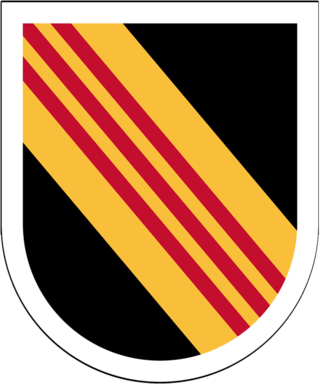
The 5th Special Forces Group (Airborne) (5th SFG (A)) is one of the most decorated active duty United States Army Special Forces groups in the U.S. armed forces. The 5th SFG (A) saw extensive action in the Vietnam War and played a pivotal role in the early months of Operation Enduring Freedom. 5th Group—as it is sometime called—is designed to deploy and execute nine doctrinal missions: unconventional warfare, foreign internal defense, direct action, counter-insurgency, special reconnaissance, counter-terrorism, information operations, counterproliferation of weapon of mass destruction, and security force assistance. As of 2016, the 5th SFG(A) is primarily responsible for operations within the CENTCOM area of responsibility as part of the Special Operations Command, Central (SOCCENT). The 5th SFG (A) specializes in operations in the Middle East, Persian Gulf, Central Asia, and the Horn of Africa (HOA). The 5th SFG (A) and two of its battalions spend roughly six months out of every twelve deployed to Iraq as Combined Joint Special Operations Task Force – Arabian Peninsula.
The red beret is a military beret worn by many military police, paramilitary, commando, and police forces and should not be confused with the maroon beret worn by airborne troops all around the world.

The Special Warfare Memorial Statue — known informally as Bronze Bruce — was the first memorial in the United States to soldiers who had served in the Vietnam War. It was created in 1968 by sculptor Donald De Lue (1897-1988) and dedicated on November 19, 1969. The statue is the centerpiece of the U.S. Army Special Operations Command's Memorial Plaza at Fort Liberty, North Carolina, which honors all Army special operations soldiers. The statue depicts a Special Forces soldier as most all of the Army special operations soldiers killed in Vietnam were SF.
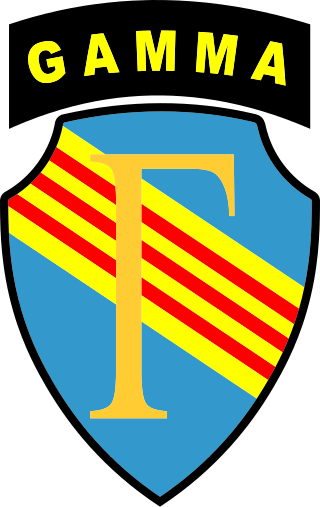
Project GAMMA was the name given in 1968 to Detachment B-57, Company E, 5th Special Forces Group (Airborne) in Vietnam from 1967 to 1970. It was responsible for covert intelligence collection operations in Cambodia. The teams were highly effective at locating Viet Cong operations in Cambodia, leading to their destruction. When assets began to disappear, they identified a South Vietnamese officer as the mole. On the advice of the CIA, they took extrajudicial steps and murdered him. Seven officers and one non-commissioned officer were arrested and tried. When the CIA refused to answer summons for witnesses for national security reasons, the charges were dropped.
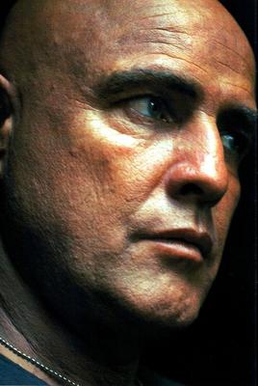
Colonel Walter Kurtz, portrayed by Marlon Brando, is a fictional character and the main antagonist of Francis Ford Coppola's 1979 film Apocalypse Now. Colonel Kurtz is based on the character of a nineteenth-century ivory trader, also called Kurtz, from the 1899 novella Heart of Darkness by Joseph Conrad.

The Special Forces Regiment (Airborne) is a Special Operations Forces unit of the Philippine Army. The unit is based on and continually trains with its American counterpart, the U.S. Army Special Forces (Green Berets).

Robert Bradley Rheault was an American colonel in the U.S. Army Special Forces who served as commander of the First Special Forces Group in Okinawa, and the Fifth Special Forces Group in Vietnam from May to July 1969.

The U.S. Army Special Forces traces its roots as the Army's premier proponent of unconventional warfare from purpose-formed special operations units like the Alamo Scouts, Philippine guerrillas, First Special Service Force, and the Operational Groups (OGs) of the Office of Strategic Services. Although the OSS was not an Army organization, many Army personnel were assigned to the OSS and later used their experiences to influence the forming of Special Forces.
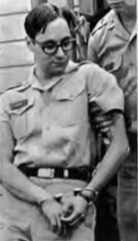
The court-martial of Howard Levy occurred in 1967. Howard Levy was a United States Army doctor who became an early resister to the Vietnam War. In 1967, he was court-martialed at Fort Jackson, South Carolina, for refusing an order to train Green Beret medics on their way to Vietnam. He said it "became clear to me that the Army [was using medics] to 'win hearts and minds' in Vietnamese villages - while still burning them to the ground in search-and-destroy missions." He considered the Special Forces "killers of peasants and murderers of women and children".


